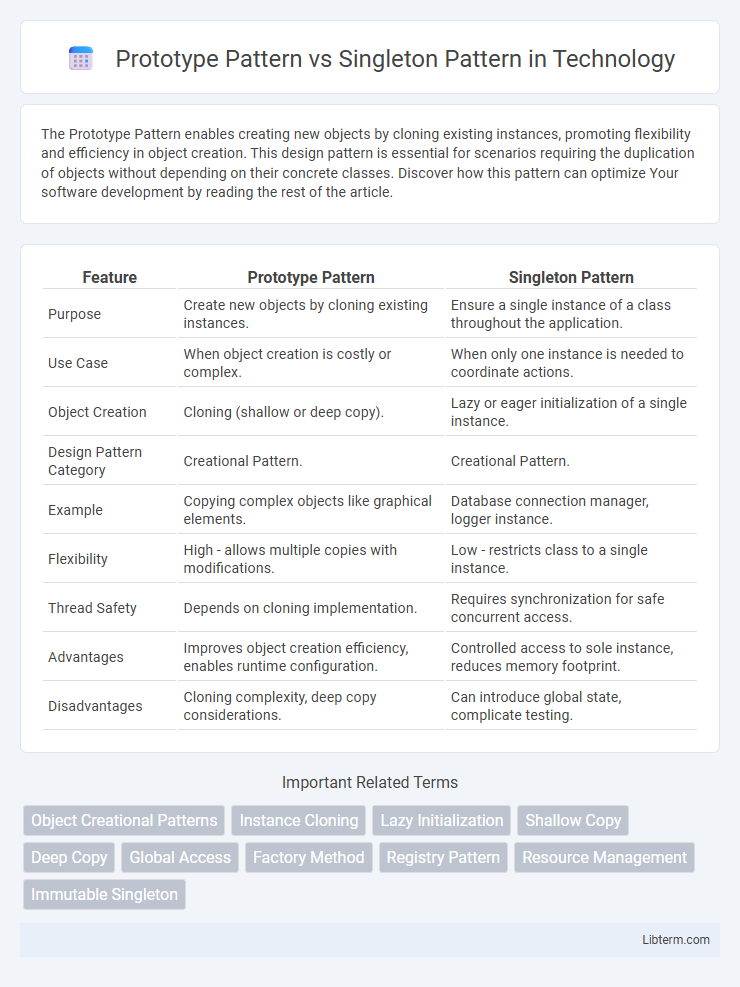The Prototype Pattern enables creating new objects by cloning existing instances, promoting flexibility and efficiency in object creation. This design pattern is essential for scenarios requiring the duplication of objects without depending on their concrete classes. Discover how this pattern can optimize Your software development by reading the rest of the article.
Table of Comparison
| Feature | Prototype Pattern | Singleton Pattern |
|---|---|---|
| Purpose | Create new objects by cloning existing instances. | Ensure a single instance of a class throughout the application. |
| Use Case | When object creation is costly or complex. | When only one instance is needed to coordinate actions. |
| Object Creation | Cloning (shallow or deep copy). | Lazy or eager initialization of a single instance. |
| Design Pattern Category | Creational Pattern. | Creational Pattern. |
| Example | Copying complex objects like graphical elements. | Database connection manager, logger instance. |
| Flexibility | High - allows multiple copies with modifications. | Low - restricts class to a single instance. |
| Thread Safety | Depends on cloning implementation. | Requires synchronization for safe concurrent access. |
| Advantages | Improves object creation efficiency, enables runtime configuration. | Controlled access to sole instance, reduces memory footprint. |
| Disadvantages | Cloning complexity, deep copy considerations. | Can introduce global state, complicate testing. |
Introduction to Design Patterns
The Prototype Pattern enables object creation by cloning existing instances, promoting efficient copying of complex objects without depending on their concrete classes. The Singleton Pattern ensures a class has only one instance while providing a global point of access, useful for managing shared resources or configurations. Both patterns address object creation but differ in intent: Prototype focuses on cloning objects, whereas Singleton controls instance uniqueness.
Overview of Prototype Pattern
The Prototype Pattern enables creating new objects by cloning existing instances, promoting flexibility and efficiency in object creation without relying on subclasses. It is particularly useful when the cost of creating a new object is high or complex, as it allows for duplication through a prototype interface. This pattern contrasts with the Singleton Pattern, which restricts class instantiation to a single instance, focusing on global access rather than object cloning.
Overview of Singleton Pattern
The Singleton Pattern ensures a class has only one instance while providing a global point of access to that instance, commonly used for managing shared resources like configuration settings or database connections. It restricts instantiation by making the constructor private and controlling instance creation through a static method. This pattern optimizes memory usage and enforces a single state, critical in scenarios requiring consistent and centralized management.
Key Differences Between Prototype and Singleton Patterns
The Prototype Pattern enables object cloning to produce new instances, promoting flexibility in object creation, while the Singleton Pattern restricts a class to a single instance, ensuring controlled access. Prototype relies on a copy mechanism to replicate an object's state, supporting diverse configurations, whereas Singleton enforces global state consistency through a unique instance. Key differences include Prototype's emphasis on object duplication versus Singleton's focus on instance uniqueness and controlled access.
Use Cases for Prototype Pattern
The Prototype Pattern is ideal for scenarios requiring the creation of numerous objects that share a similar structure but differ in state, such as cloning complex configurations or objects with costly initialization. It provides performance benefits by copying existing objects rather than building new ones from scratch, making it suitable for game development, graphic applications, and object pooling. This pattern supports dynamic runtime object creation and customization, distinguishing it from the Singleton Pattern, which ensures a single global instance for shared resources like logging or configuration management.
Use Cases for Singleton Pattern
Singleton Pattern is ideal for managing shared resources such as database connections, logging instances, or configuration settings where a single point of control is essential. It ensures controlled access to a sole instance, preventing conflicts and maintaining consistent state across an application. This pattern is commonly used in scenarios like thread pooling, caching, and device driver management where resource contention and state synchronization are critical.
Advantages of Prototype Pattern
The Prototype Pattern enables object cloning, allowing new objects to be created efficiently without depending on subclass constructors, which reduces the overhead of repeated initialization. It supports dynamic and flexible object creation, making it ideal for situations where complex objects need to be copied with slight modifications. Unlike the Singleton Pattern, which restricts a class to a single instance, the Prototype Pattern facilitates the creation of multiple distinct objects while preserving performance and memory resources.
Advantages of Singleton Pattern
The Singleton Pattern ensures a single, globally accessible instance, reducing memory overhead and preventing conflicts caused by multiple instances. It provides controlled access to shared resources, enhancing consistency and thread safety in concurrent environments. This pattern simplifies resource management and improves performance by avoiding unnecessary object creation.
Common Pitfalls and Misconceptions
Common pitfalls with the Prototype Pattern include overlooking deep copy requirements, leading to shared mutable state and unexpected side effects, while Singleton Pattern often suffers from misuse in multithreaded environments, causing multiple instances due to improper synchronization. A frequent misconception is that the Prototype Pattern always improves performance, ignoring that cloning complex objects can be costly and error-prone. Singleton Pattern is often mistaken for a global variable replacement, which can introduce hidden dependencies and hinder unit testing.
Choosing the Right Pattern for Your Project
Choosing the right design pattern depends on the specific needs of your project; the Prototype Pattern excels when creating new objects by cloning existing ones improves performance and flexibility. The Singleton Pattern is ideal for ensuring a single, globally accessible instance, such as database connections or configuration managers. Evaluate your project's requirements for object creation frequency, resource management, and global state control to determine which pattern best optimizes code maintainability and scalability.
Prototype Pattern Infographic

 libterm.com
libterm.com